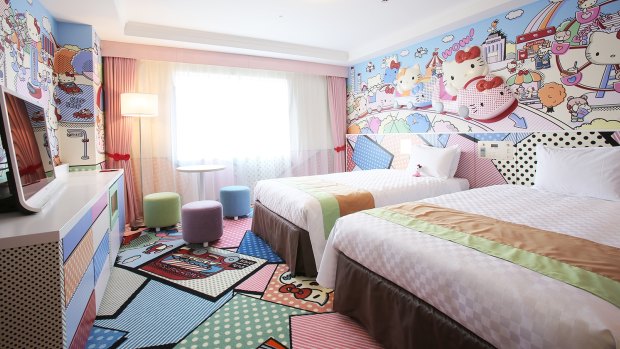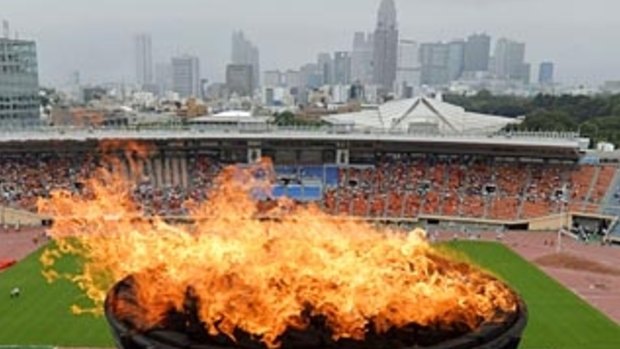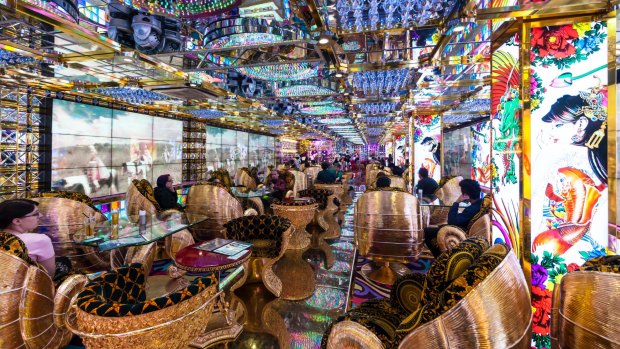This was published 4 years ago
What to expect in Tokyo, Japan as it prepares for the Rugby World Cup in 2020
By David McGonigal

Keio Plaza Hotel, Japan.Credit: TAKEUCHI KENJI
Enshin Sakurai is not your average Buddhist monk. Trained near Kyoto and university educated in San Francisco, he also has a strong interest in sport. Based at Jindai-ji temple in Chofu not far from Tokyo Stadium where Australia will face Wales in the Rugby World Cup on September 29, he worked with the Wallabies in 2018 to bring them good fortune. He hopes to do so again.
When I meet Enshin he takes me on a tour of his temple in the forest, the second oldest in Tokyo. Built in 733 AD it's far enough off the beaten track to be quiet and tranquil. That's until the morning serenity is interrupted by the daily Goma fire ceremony, with monks chanting to an intoxicating drum beat. Momentarily I wish I was a junior monk with a good sense of rhythm.
I ask Enshin about his Australian rugby connection and he explains the principle of the Daruma doll that can help set goals and bring good luck. He was invited to elaborate on this to the Wallabies team before an All Blacks test in Yokohama in October 2018. Sadly NZ won 37-20. There's a limit to what good luck can achieve.

A flame is ignited at the Olympic cauldron, which was used at the 1964 Tokyo Olympics, at National Stadium in Tokyo to celebrate the city's successful bid to host the 2020 Olympics.Credit: AP
I ask Enshin if he will meet the Wallabies before the forthcoming RWC and he replies "I hope so." Showing great diplomacy, when I ask who he'll be barracking for if Australia plays Japan he answers "I want neither to lose". He confesses to a passing interest in rugby but passionate support of Nagoya's baseball team.
Japan has two international sporting events coming up. After the RWC the Tokyo 2020 Summer Olympics and Paralympics begin in July. Improved English-language signage in the Tokyo Metro, removing pornography from major convenience-store chains and reducing indoor smoking are all under way.
While the Wallabies are scheduled to play just one game at Tokyo Stadium, three finals will also be played there. The stadium is located about an hour west of the city. The closest station is Tobitakyu on the Keio Line and the ubiquitous Keio Corporation is a major shareholder in Tokyo Stadium as well as owning hotels and department stores.

Sensory overload at Robot Restaurant.Credit: Alamy
HERE KITTY KITTY
While I'm staying at Keio Plaza Hotel in Shinjuku I make the trek out to Keio Plaza Hotel Tama to see several rooms dedicated to Hello Kitty. From the carpet to the ceiling, lampshades and bathroom everything is cloyingly Hello Kitty. The rooms are booked out months in advance mainly by adult couples. Even the hotel's restaurant serves Hello Kitty dishes including that familiar face on top of my cappuccino. Guests arriving by metro are welcomed by an intricate Hello Kitty ceiling mural as they exit the turnstiles. All this concentrated Hello Kitty-ness is because Tama is the home of Sanrio Puroland, a Hello Kitty theme park. Hello Kitty-embracing rugby fans can have it all as Tama isn't far from Tokyo Stadium.
Alternatively, Takadanobaba neighbourhood is the home of Astro Boy and his creator, the late manga genius Osamu Tezuka. There are two large Astro Boy tribute murals under the rail overpass and the Japan Rail platforms play the Astro Boy theme. Indeed, every Tokyo metro station has its own theme music, a boon for visually-impaired or language-challenged travellers, so you can seek out the Star Wars theme or the theme from The Third Man.
UNIVERSAL ACCESS
"While the 2020 Paralympics brings universal access to the forefront, there is a significant proportion of regular travellers who benefit from adaptable rooms," a spokesperson for Keio Plaza Tokyo tells me. "So we were delighted in May 2019 when Andrew Parsons, the president of the International Paralympic Committee, singled out our hotel as setting the standard other hotels should aspire towards."
A tour of the hotel's 13 universal access rooms and suites, all on the 30th floor, reveals clever and sympathetic design. That extends from a lift that has voice assistance and doors that open and close more slowly to raised numbers on the guest rooms and switches at wheelchair height. There's special lighting for visually impaired guests and features such as vibrating cushions for hearing-impaired guests. The rooms have electric beds and chairs yet look elegant rather than clinical and, endearingly, each provides a dedicated mat and bowls and toilet facilities for special assistance dogs.
I AM THE GREATEST
With sport so much in mind, it's great to visit the hotel's Imperial Suite where Muhammad Ali stayed in 1976. Back then his suite overlooked fields and a water purification plant, not today's sea of neon. The suite has been kept much as it was when "The Greatest" stayed but is updated for modern needs. Sean Connery's James Bond would recognise the decor, but there are USB charging ports by the bedside. It's no longer the hotel's premier suite but rather a wonderful reflection of the past.
TOO TOKYO
Tokyo has always been too unusual, and sometimes incomprehensible, to be a generic "global standard" city. But returning visitors will find more foreign-language signs, more cashless payment, Australian phones now work here and there are fewer ashtrays. And there's a new fish market. But Tokyo's pure foreign-ness remains. There are still young people dressed as anime characters shopping for fashion and elaborate ice-creams in the narrow lanes of Harajuku. Coffee shops where you share a table with hedgehogs, kittens, puppies, miniature pigs and bunnies abound. Crowds still fill the pedestrian crossing at Shibuya as up to 2500 people cross at each green light.
The metro is still crowded but it's so well coded by colour, numbers and sounds that anyone can navigate it. At cafes plastic displays and photographic menus show exactly what food you'll be served. Neon challenges your senses after dark, especially around Shinjuku where a rooftop Godzilla looms over the streetscape. While the main streets are mainstream there are tiny lanes filled with bars for half a dozen patrons or smaller ramen shops that appear to have been serving the same dishes for generations. Golden Gai is perhaps the best known. Another is Omoide Yokocho or Memory Lane, a remnant of the post WWII black market still often referred to by its old name of "Piss Alley", that is ironically the most picturesque of all.
ROBOT RESTAURANT
Even within the neon extravaganza of Shinjuku's pulsing nightlife Robot Restaurant stands out for its excess of glitz. If you come to Tokyo with any preconceptions prepare to have them fulfilled here, as brightly costumed warrior women astride "robots" battle anime-like aliens with laser-beam overload and awful music. It's enormous fun. Even the bar where you gather pre-show is a profusion of coloured lights (and a "robot" band) that has been best described as "like a glitter factory exploded and the explosion was so loud and violent that it caused a unicorn to vomit rainbows all over the walls".
The only Japanese people inside are the performers who give their all. It's impossible not to sing and dance and clap along. When we are ejected back onto the street it's increasingly difficult to believe it wasn't all an hallucination. It added nothing to my understanding of Japan apart from appreciation of playfulness and induced colour blindness.
WORLD CUP COCKTAILS
Back at the hotel, I need a drink not served by a robot so I head to Brillant, the main bar. It's a blend of comfortable armchairs and towering walls of unfinished brick. By now it's no surprise to find there's a seasonal list of Rugby-inspired cocktails created by Yosuke Nakane, the resident bartender and rugby fan, with names like Scrum, Screw Pass and No. 8. But I can't go past a Brave Blossom, named after Japan's national rugby team, a sake-based cocktail with cherry blossoms, ginger and Japanese basil. It's delicious. From wish-fulfilling monks to sake rugby cocktails it looks like Tokyo is match ready.
TRIP NOTES
FLY
ANA, JAL, Jetstar and Qantas all offer non-stop services from Australia to Tokyo.
STAY
The Keio Plaza Hotel is a few minutes from the major hub of Shinjuku station. It's a large comfortable hotel that is luxurious in its executive Premier Grand floors. Standard double room from $300 and Premier Grand from $580. See keioplaza.com.
SPORT
The Rugby World Cup starts on September 20 with the final scheduled for November 2. Australia is in Pool D and plays Fiji in Sapporo, September 23; Wales in Tokyo, September 29; Uruguay in Oita, Kyushu, October 5; and Georgia in Ecopa, October 11. See rugbyworldcup.com
The 2020 Summer Olympics will take place in Tokyo from July 24 to August 9, followed by the 2020 Summer Paralympics from August 25 to September 6. See tokyo2020.org
MORE
David McGonigal was a guest of Keio Plaza Hotel
Sign up for the Traveller Deals newsletter
Get exclusive travel deals delivered straight to your inbox. Sign up now.